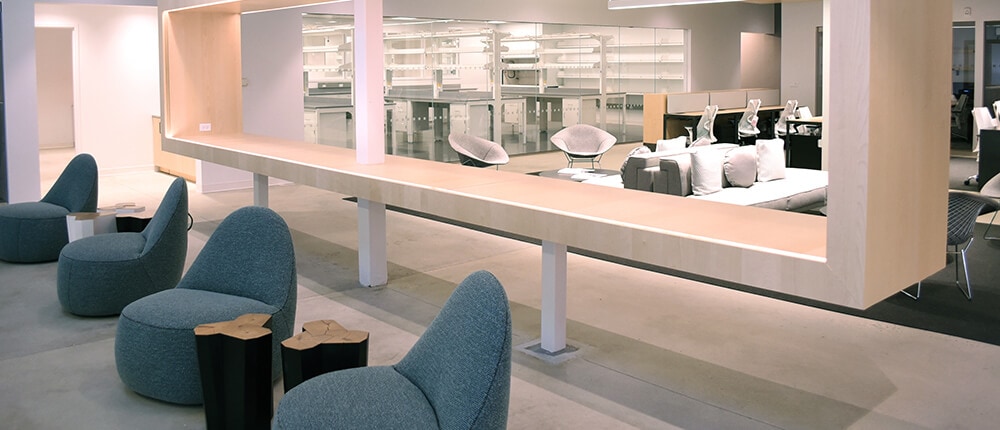Courting the innovation economy: ‘We have everything right here at our fingertips’

Tucked deep within the woods on the outskirts of town, Princeton Innovation Center BioLabs might sport as much of a Silicon Valley vibe as any in the West Coast tech community.
And to its designers’ credit, that was the intended measure: The 31,000-square-foot center is one of New Jersey’s 29 incubators, which along with 31 co-working facilities and seven accelerators, are aimed at kick-starting the state’s tech startup economy.
These spaces, according to BioNJ President and CEO Debbie Hart, promote “a collaborative environment where [startups] could learn from each other, inspire each other and share information.” The sites have deliberately open floor plans with row upon row of computer docking stations and lounges, sprawling cafeterias and laboratory-style workspaces.
The Princeton site served as the backdrop for the July 25 unveiling of two new economic incentives Gov. Phil Murphy said are aimed at bringing STEM industries back to the state.
The first involves a program in which the Economic Development Authority will subsidize two, four or six months of a qualifying company’s rent. The other represents a revamp of the state’s research and development tax credit.
“Both of these initiatives will allow us to take full advantage of all New Jersey has to offer entrepreneurs and startups as well as our established innovation-driven companies,” Murphy said at the time. “We have everything right here at our fingertips to dominate the innovation economy.”
Under the rent-relief program, dubbed the Incubator and Collaborative Workspace Rent Initiative, the EDA will subsidize a startup’s rent at an incubator, accelerator or other collaborative workspace.
The program will start with an initial $500,000 investment, with a maximum of $15,000 in aid per applicant, and the workplace will commit to subsidizing half the amount.
The EDA would provide up to three months in bonuses if the collaborative workspace is newly opened, established in one of the state’s Federal Opportunity Zones or affiliated with a hospital system or New Jersey university.
Murphy said the program would allow businesses to focus on talent acquisition and product development, rather than costly overhead expenses.
“New Jersey lost young companies in the past, because one side is Philadelphia [and] the other side is New York City. They created very friendly ecosystems for young companies in the past,” said Serpil Guran, director of the Rutgers EcoComplex in Bordentown, where lab space is available for startups to commercialize their green technology.
There currently are 13 such startups operating at the EcoComplex, Guran said.
“These are very young companies and if they are supported, they are going to be able to offset their rent and it is going to help them hire more people [and] buy new equipment instead of paying rent,” she said.
Companies often have to utilize costly equipment to develop prototypes, which alone might eat into what little profit they have in their coffers, according to Guran.
“We would like to, if we could support it, provide that shared equipment,” she said.
The revamped R&D tax credit, the first major change to the program since 1992, will allow the state to diversify its recipients, Murphy said.
‘While many positive changes have been made to the federal R&D tax credit over the past 26 years, New Jersey’s program has stayed within its original 1992 criteria,” Murphy said. “This means innovative companies here have been missing out on new eligible research categories, new calculation methods and even larger available credits. This also means that we’ve been at a competitive disadvantage with our competitor states, which have already modernized their credit programs.”
New Jersey will instead abide by the 2015 federal standards on the R&D tax credit, meaning it is calculated as an exemption on the corporate business tax, according to Jennifer Sciortino, a spokesperson for the New Jersey Department of the Treasury.
Though Murphy signed an increase to the corporate business tax, the rate hikes will only apply to companies with at least $1 million in net income, otherwise the rate will remain at 9 percent, 7.5 percent or 6 percent depending on annual net income.
The R&D is calculated as a credit against the CBT, equal to 10 percent of qualified research over a base amount, plus 10 percent of the basic research payments, according to Sciortino.
“If Pharma Company A spends $100 on qualified research expenses over their base research spending, and spends $100 on basic research payments, then they will receive a $20 R&D tax credit,” she said.
“By making the credit easier to take we expect it to benefit a number of sectors, including pharma, energy, defense and aerospace, computer/tech and infrastructure,” Sciortino added.
In the 2018 fiscal year, New Jersey doled out $80 million in R&D tax credits to 200 recipients, mainly in the pharmaceutical, telecommunications and advanced technology industries.
Sciortino said that the treasury didn’t have an estimate on how much the state expects to give in R&D tax credits through the end of the 2019 fiscal year.